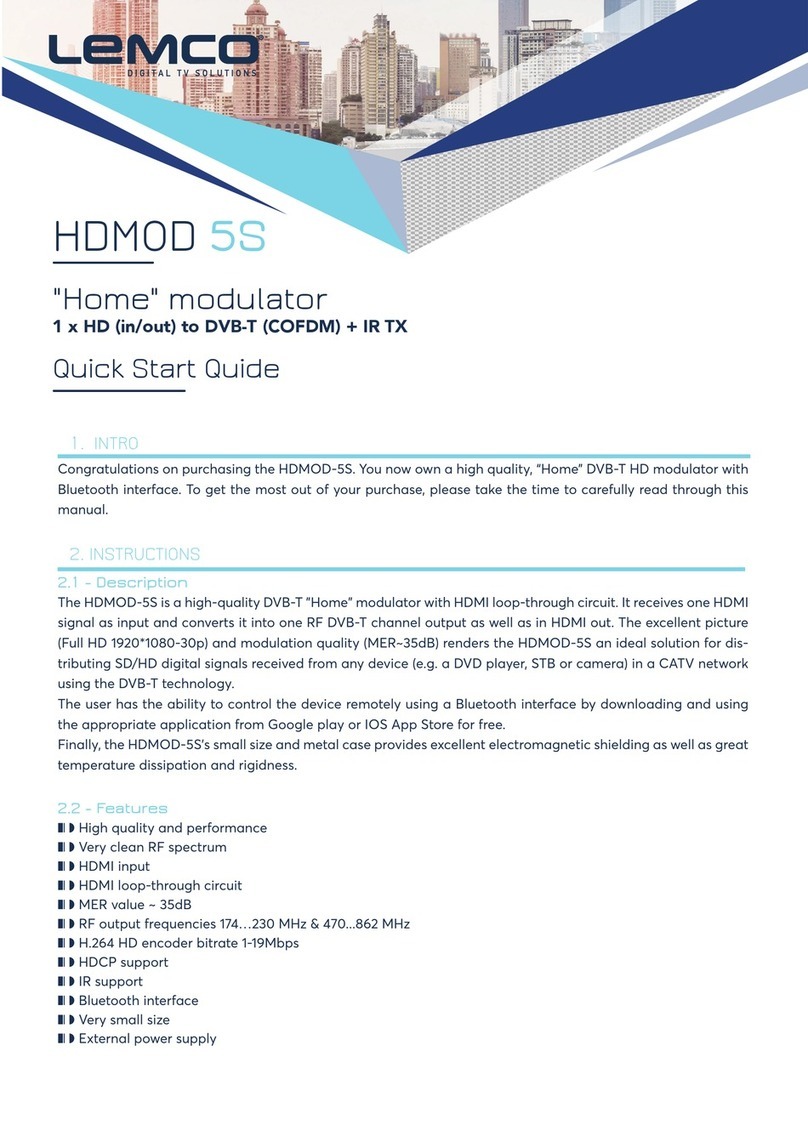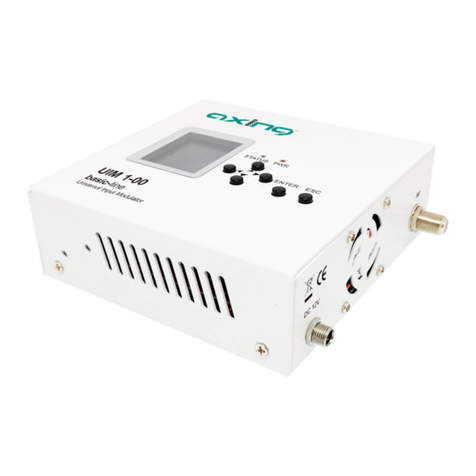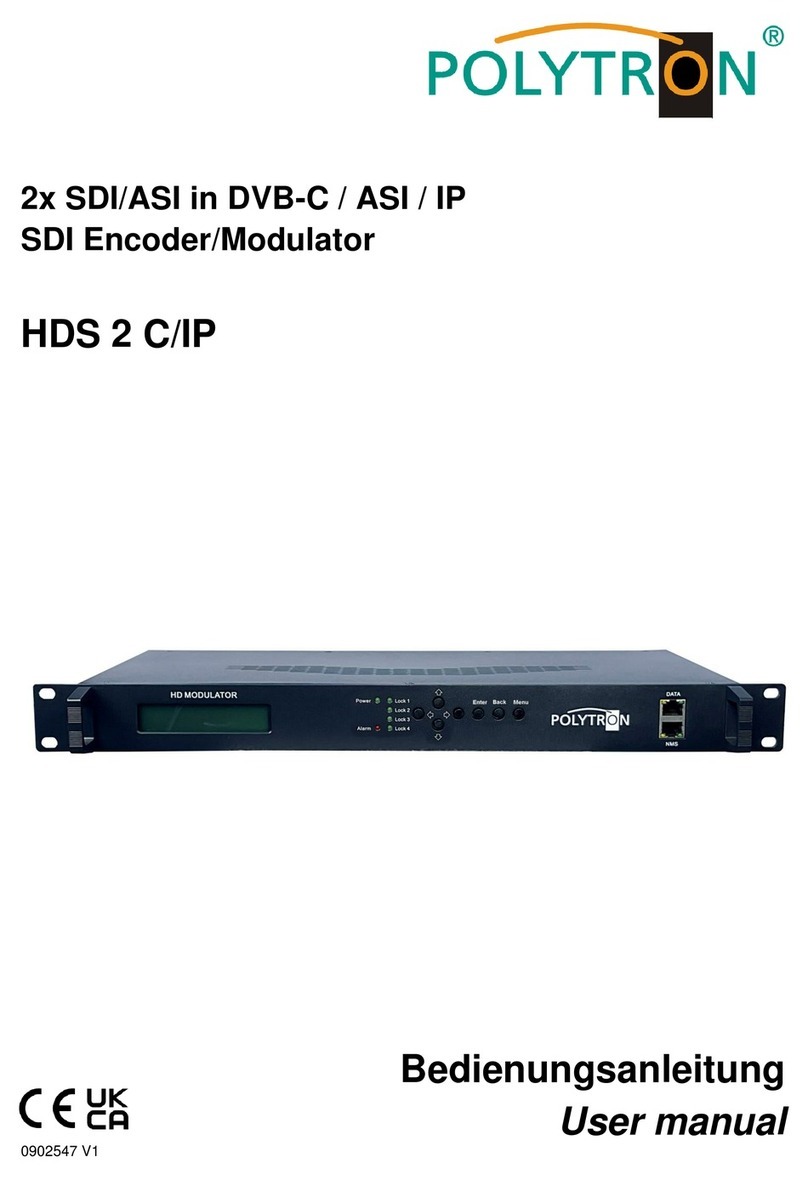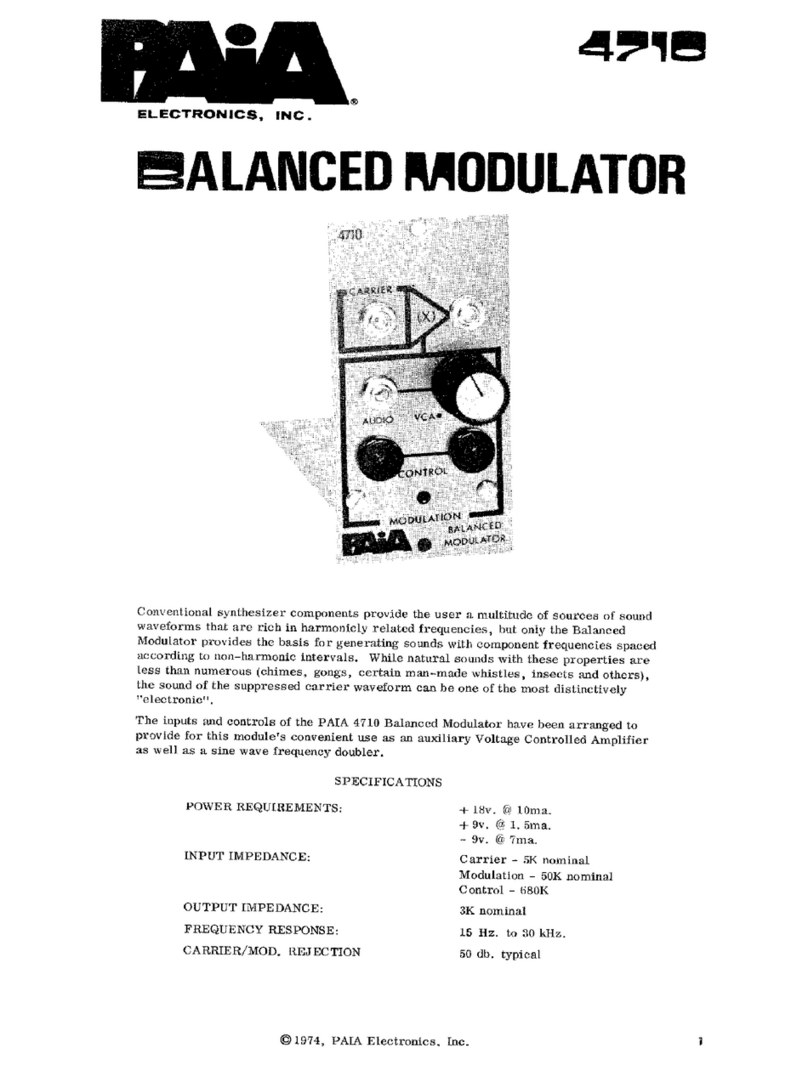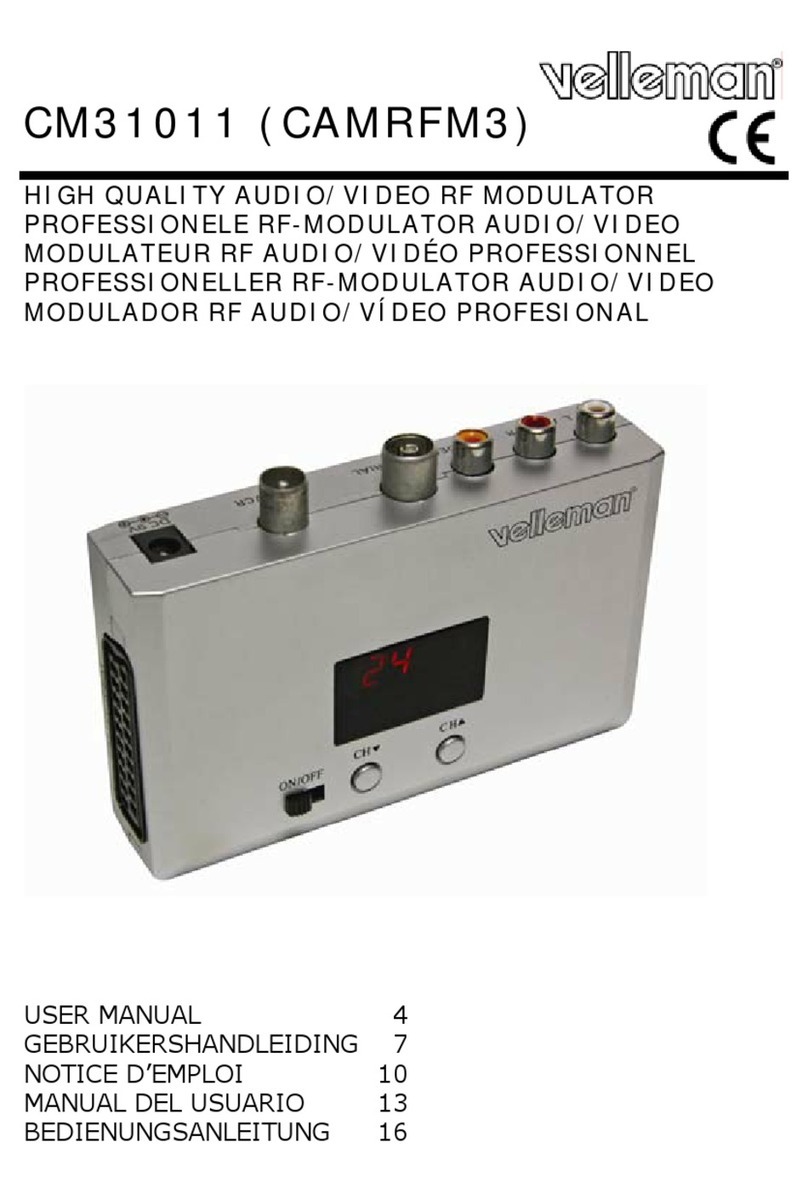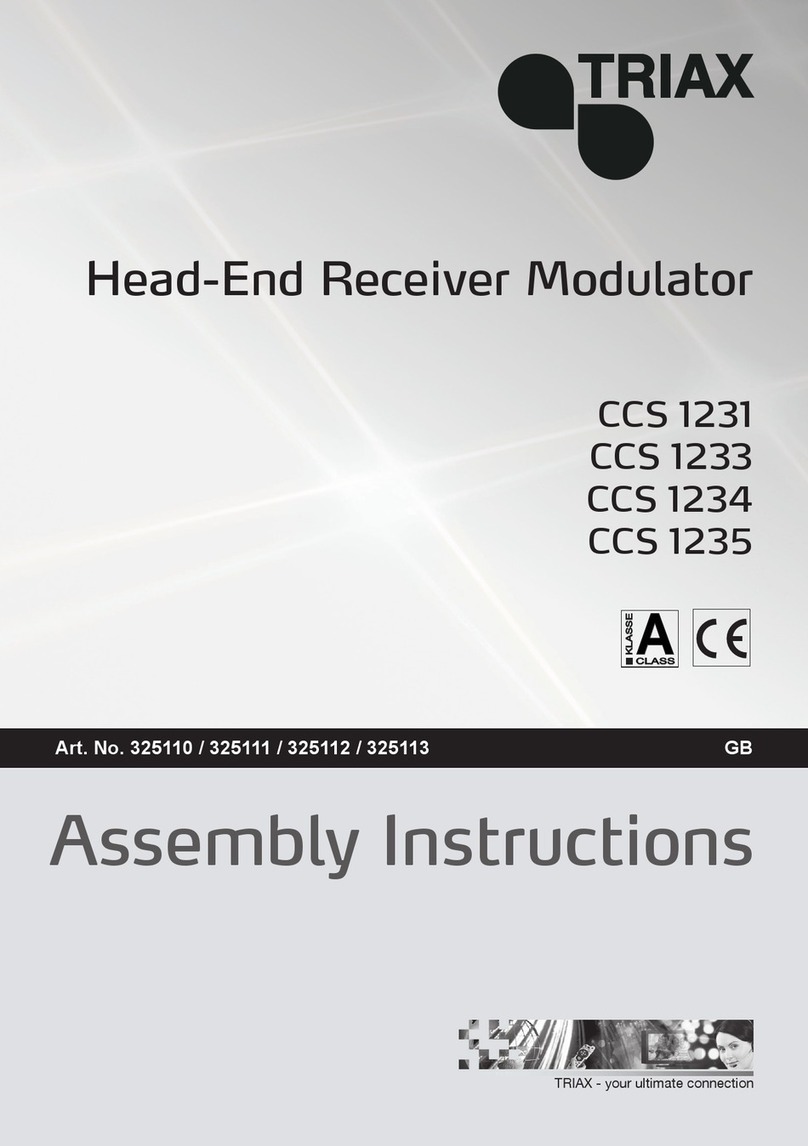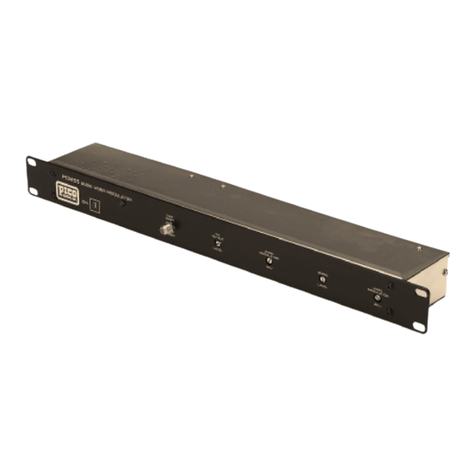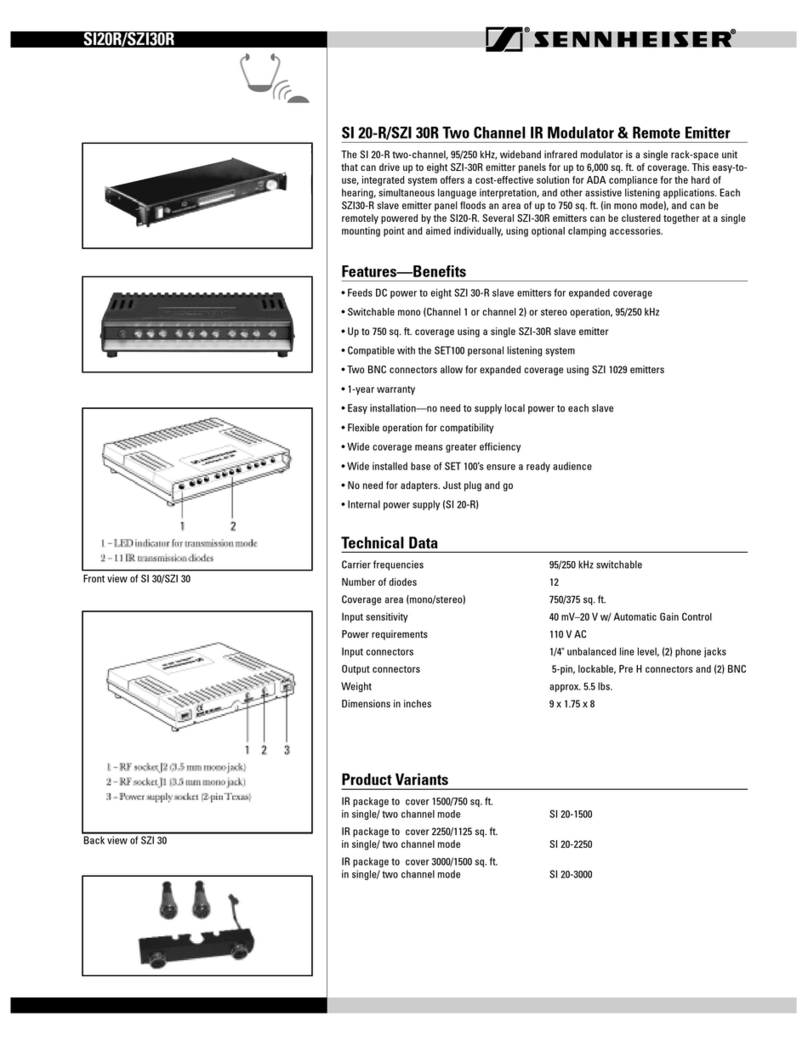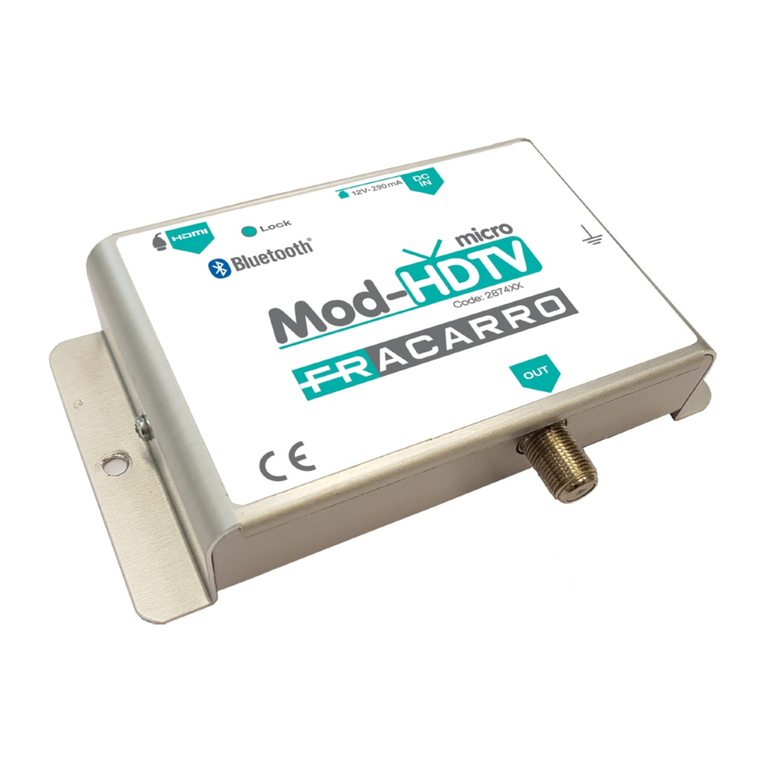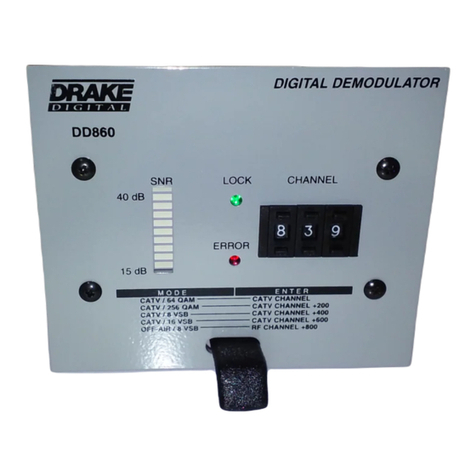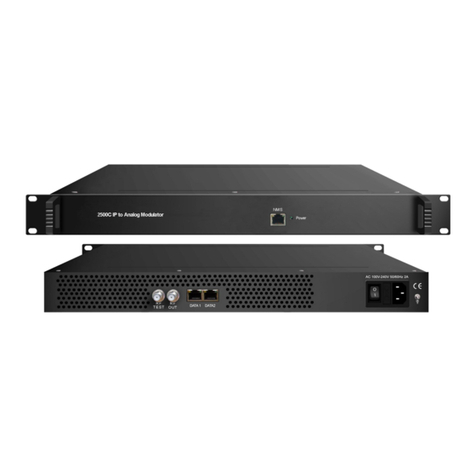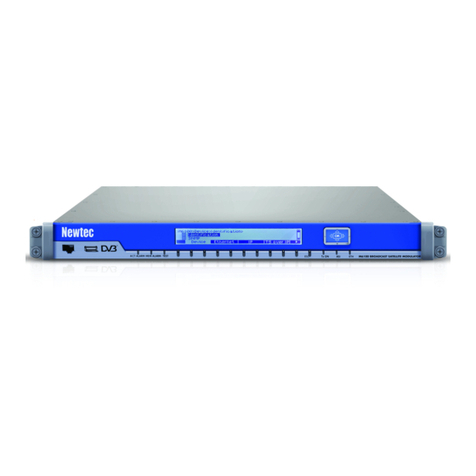STARLINK ST-7000 Series Guide


Introduction
■ Multiple Video Input with Single Modulation Output
ST-7000 Single Channel High-Definition (HD) modulator provides single channel delivery of multiple
video/audio digital/analog sources over signal coaxial cable. HD video output resolution can be up
to 1080p @ 30 fps with adjustable output power level from 70 to 100
dBµV
in 1 dB step.
Output frequency ranges from 50 MHz to 860 MHz in 6 MHz, 7 MHz or 8 MHz channel bandwidth
depending on the modulation technique.
The operation of ST-7000 is intuitive by using on-panel keypad and 2.4” color LCD screen.
1
ST-7000 Series HD Modulator
■
Input
● HDMI
● CVBS (RCA A/V)
● 75Ω F
ATSC (8VSB) or
J.83B or
DVB-T or
ISDB-T(b) or
DVB-C
■
Output
● 75Ω F
ATSC (8VSB) or
J.83B or
DVB-T or
ISDB-T(b) or
DVB-C

Overview
■ Package Content
•ST-7000 modulator
•Mini USB-male / A-male cable
•Coaxial cable (RG6)
•HDMI Cable
•AC/DC power adapter
•Start Guide
•2.4” color LCD
•Keypad
•Return or escape to
upper level menu and
confirm the current
operation
•
◄►▲▼ Arrow keys to traverse
between fields or
increase / decrease
selected field value
• Confirm the selection
•LEDs
•PWR solid red Power is up
•HD solid red No HDMI input
solid amber HDMI input detected
•CVBS solid amber AV input detected
■ Operation Panel
•Available video/audio source from
Cable TV, antenna and HDMI device
•Available TV set
•Available electrical power socket
Front Panel
•RF-OUT Modulated RF output, 75Ω F
•ANT-IN Antenna or Cable RF Input, 75Ω F
•HD IN HDMI Input, HDMI
•RCA IN CVBS AV Input
•DC 12V IN Power Input
•GND Grounding
Back Panel
•1000Base-T Gigabit Ethernet, RJ-45
•Mini USB USB for software upgrade from PC
•Cable TV (USA) J.83B
•Over-the-Air TV (USA) ATSC (8VSB), ATSC3
•Cable TV (EU, SA)DVB-C (J.83A/C)
•Over-the-Air TV (CO) DVB-T
•Over-the-Air (SA) ISDB-T(b)
■ Installation Requirement
■ Peripheral Interface
■ TV Standards
2
ST-7000 Series HD Modulator

LCD Configuration Menu
■
Modulation
♦Country press◄► to show the country list, ▲▼ to select country. Depending on the
Modulation mode selected, channel plan of selected country will be loaded
for Channel Plan and Frequency setup. If channel plan is unavailable for your
country, select the nearby country.
♦Channel Plan press◄► to show the channel table to select, ▲▼ to traverse, OK to select
HDMI output frequency from channel table.
♦Frequency press OK to edit HDMI output frequency, ◄► to move cursor and ▲▼ to
change frequency in modulation range, press RETURN to save and escape.
♦RF Output Level press◄► to change RF output level between 70 and 100 dBµV.
♦Bandwidth press◄► to change modulation channel bandwidth.
♦Signal Source press◄► to select HDMI (digital) or CVBS (optional composite analog) signal
source.
♦LCN press OK to edit LCN, ◄► to move cursor and ▲▼ to change LCN,
press RETURN to save and escape.
♦Channel No. press OK to edit HDMI channel number, ◄► to move cursor and ▲▼ to
change channel number, press RETURN to save and escape.
♦Subchannel No. press OK to edit HDMI subchannel number, ◄► to move cursor and ▲▼ to
change subchannel number, press RETURN to save and escape.
♦Program Name press OK to edit program name with alphanumerical soft keypad,
press RETURN to save and escape.
■
DVB Settings
♦Technique Press ◄► to change modulation technique.
♦Symbol Rate press OK to edit symbol rate in MHz, ◄► to move cursor and ▲▼ to change
symbol rate.
♦Code Rate Press ◄► to change code rate.
♦Carrier Type Press ◄► to change carrier type.
♦Guard Interval Press ◄► to change guard band interval.
♦Interleaving Press ◄► to change interleaving
■
Transport Stream (TS) Settings
♦NID Network ID between 1 and 65535.
♦ONID Organization Network ID between 1 and 65535.
♦TSID Transport Stream ID between 1 and 65535.
♦SID Service Stream ID between 1 and 65535.
♦PMT PID Program Map Table (PMT) Packet ID (PID) between 1 and 8191.
♦Video PID Video Packet ID (PID) between 1 and 8191.
♦Audio PID Audio Packet ID (PID) between 1 and 8191.
press OK to edit IDs, ◄► to move cursor and ▲▼ to change values,
press RETURN to save and escape.
♦Service Provider
press OK to edit service provider name with alphanumerical soft keypad,
press RETURN to save and escape.
♦Network Name
press OK to edit network name with alphanumerical soft keypad,
press RETURN to save and escape.
■
System Setup
♦OSD Language
press◄► to change on-screen-display language.
♦Modulator Type
press◄► to change modulator type.
♦Key Tone
press◄► to toggle keypad beep sound between ON and OFF.
♦IP Address
press OK to edit IP Address, ◄► to move cursor and ▲▼ to change value,
press RETURN to save and escape.
♦ Cooling Fan
press◄► to toggle cooling fan between ON and OFF.
♦Factory Reset press OK to reset and restore factory defaults.
3
ST-7000 Series HD Modulator

Modulation Attributes
■
ATSC
♦Modulator Type ATSC-Air (8VSB) or ATSC-Cable (J.83B)
♦Frequency Range 50 MHz to 860 MHz
♦Channel Bandwidth 6 MHz
♦Technique ATSC 8VSB
J.83B 64QAM, 128QAM, 256QAM
♦ MER ≥35 dB
■
DVB-T
♦Frequency Range 50 MHz to 860 MHz
♦Channel Bandwidth 6 MHz (Colombia/Panama), 7 MHz (Australia),
8 MHz (Europe, New Zealand)
♦Technique 16QAM, 64QAM, QPSK
♦Carrier Type 2K. 8K
♦ Code Rate 1/2, 2/3, 3/4, 5/6, 7/8
♦ Guard Interval 1/4, 1/8, 1/16. 1/32
■
ISDB-T(b)
♦Frequency Range 50 MHz to 860 MHz
♦Channel Bandwidth 8 MHz
♦Technique 16QAM, 64QAM, DQPSK, QPSK
♦Carrier Type 2K. 4K, 8K
♦ Code Rate 1/2, 2/3, 3/4, 5/6, 7/8
♦ Guard Interval 1/4, 1/8, 1/16. 1/32
♦ Interleave Mode 1, Mode 3, Disabled. Used for robustness of
Forward Error Correction (FEC).
■
DVB-C
♦Frequency Range 50 MHz to 860 MHz
♦Channel Bandwidth 8 MHz
♦ Symbol Rate editable, 6.875 Mbps
♦Technique 16QAM, 32QAM, 64QAM, 128QAM, 256QAM
■ Audio Codec
Audio encoding is automatically selected by the Modulator to reach the best quality according to local
modulation technique.
AC3 2.1 Dolby Digital Audio coding applies to ATSC (8VSB) broadcasting in North America.
MPEG MPEG-2 Layer 1 audio coding applies to DVB-T broadcasting in Europe and South America.
ACC Advanced Audio Coding for MPEG-4 applies to ISDB-T broadcasting in South America and certain
ATSC (8VSB) broadcasting in North America.
■ Video Quality
Video quality is optimized by determining the size and the speed to transmit MPEG packets to the TV.
The packet latency and delay variation are adjusted automatically by the Modulator to reach the best
video quality and performance on the TV.
4
ST-7000 Series HD Modulator

Before Installation
■ Choose Modulated Output Frequency for HDMI Video on TV
•Modulated output frequency of HDMI video can be any existing channel frequency available from
your local Channel Plan.
•Depending on the modulation technique of over-the-air broadcasting TV or Cable TV used in your
area, refer to the corresponding appendix for Channel Plan information.
•Select an unused or an unimportant channel from the Channel Plan as output frequency of HDMI
video.
• If you are unsure about which output frequency to be used for HDMI video
◊ Pick a frequency between channel gap, make sure it’s 6 MHz or 8 MHz away from the previous
and the next channels.
◊ Use the recommended frequency indicated on the corresponding Channel Plan appendix.
◊ Use the default frequency selected by the Modulator.
•Modulated output frequency and channel number can be configured from the LCD menu or Web
Configuration page.
• Follow the instructions of this Start Guide to set up output frequency and channel number to
watch HDMI video on your TV.
•Your TV needs to learn the HDMI video channel by auto or manual channel rescan. Refer to the
user’s guide of your TV set to practice the rescan for channel detection of HDMI video.
■ Combining (Cable) TV Signals from Service Provider (e.g. Comcast)
•In order to combine the existing TV broadcasting channels from service provider, it’s necessary to
select an output frequency and output channel (ATSC only) for Modulator’s HDMI video. The
channel information of your local over-the-air broadcasting or local Cable TV service can normally
be found online or from the channel listing table provided by your service provider.
• For business installers, a handheld spectrum analyzer up to 1 GHz can be helpful to make the
installation easier and faster although it’s not mandatory.
• If the modulator output is going to feed a Digital Cable Converter box or a set-top box, some
service providers offer a dedicated channel (and frequency) for modulated video and some service
providers may need a specific PID to be configured by the Modulator for MPEG streams to be
recognized by the set-top box. Refer to the section of MPEG Transport Stream Parameters for PID
setup.
• If the output power level of the Modulator is too high, it may oversaturate the TV signals delivered
by service providers. It’ necessary to lower the output power level or use an attenuator to reduce
the oversaturation.
5
ST-7000 Series HD Modulator

ATSC ⇐ Over-the-Air TV with HDMI Modulation
If TV signal is originally coming from an outdoor or an indoor antenna,
follow the steps below to combine the HDMI video with over-the-air TV
video.
The Modulator with default settings can work as a plug-and-play device
if it’s unsure about how to setup the output frequency of HDMI video.
If you plan to customize the settings, refer to the section Choose
Modulated Output Frequency for HDMI Video on TV to pick up the output
frequency and channel number of HDMI video.
The on-screen-display language can be changed by going to
Syatem Setup → OSD Language.
①Power on the Modulator with power adapter included in the package.
② Disconnect the end of coaxial cable connected to the RF/Antenna IN
port of the TV.
③Connect the end of the coaxial cable removed from step 2 to the ANT
IN port of the Modulator.
④Connect the RF OUT port of the Modulator to the RF/Antenna IN port
of the TV with a coaxial cable included in the package.
⑤Connect the HD IN port of the Modulator to the HDMI OUT port of
video players or input devices like DVD player, Satellite TV Set-Top
Box, Video Stream, Security Monitor ... etc.
It’s recommended to set the video output of HDMI device with fixed
resolution at 1080p or 720p.
⑥ Go through the LCD menu screen on the Modulator to configure
settings. Press OK to go to the main menu and
System Setup →Modulator Type →select ATSC-Air
Modulation →Channel Plan →select from the existing channel plan
for HDMI video frequency or
Modulation → Frequency → press OK to edit frequency in MHz with
◄►▲▼ keys
Modulation →Channel No. →press OK to edit channel number with
◄►▲▼ keys
Modulation →Subchannel No. →press OK to edit subchannel number
with ◄►▲▼ keys
Modulation →Program Name →press OK to edit channel name with
soft alphanumerical keypad
⑦ Turn on the TV. Refer to the user’s manaul of the TV and run Auto
Scan for channel detection.
⑧Change the TV channel to the channel number entered in step 6.
Default channel is channel 66.
⑨ HDMI video is displayed on the TV if HDMI video source is inserted.
Otherwise, the SATLINK logo is displayed.
Once the HDMI video source is detected and modulated, the HD LED on
panel glows solid amber.
7
6
ST-7000 Series HD Modulator

8
ATSC ⇐ Cable TV with HDMI Modulation
If TV signal is originally coming from a Cable TV coaxial drop, follow the
steps below to combine the HDMI video with Cable TV video.
The Modulator with default settings can work as a plug-and-play device
if it’s unsure about how to setup the output frequency of HDMI video.
If you plan to customize the settings, refer to the section Choose
Modulated Output Frequency for HDMI Video on TV to pick up the output
frequency and channel number of HDMI video.
The on-screen-display language can be changed by going to
Syatem Setup → OSD Language.
①Power on the Modulator with power adapter included in the package.
② Disconnect the end of coaxial cable connected to the RF/Antenna IN
port of the TV.
③Connect the end of the coaxial cable removed from step 2 to the ANT
IN port of the Modulator.
④Connect the RF OUT port of the Modulator to the RF/Antenna IN port
of the TV with a coaxial cable included in the package.
⑤Connect the HD IN port of the Modulator to the HDMI OUT port of
video players or input devices like DVD player, Satellite TV Set-Top
Box, Video Stream, Security Monitor ... etc.
It’s recommended to set the video output of HDMI device with fixed
resolution at 1080p or 720p.
⑥ Go through the LCD menu screen on the Modulator to configure
settings. Press OK to go to the main menu and
System Setup →Modulator Type →select ATSC-Cable
DVB Settings →Constellation →select 64QAM or 256QAM
Modulation →Channel Plan →select from the existing channel plan
for HDMI video frequency or
Modulation → Frequency → press OK to edit frequency in MHz with
◄►▲▼ keys
Modulation →Channel No. →press OK to edit channel number with
◄►▲▼ keys
Modulation →Subchannel No. →press OK to edit subchannel number
with ◄►▲▼ keys
Modulation →Program Name →press OK to edit channel name with
soft alphanumerical keypad
⑦ Turn on the TV. Refer to the user’s manual of the TV and run Auto
Scan for channel detection.
⑧Change the TV channel to the channel number entered in step 6.
Default channel is channel 66.
⑨ HDMI video is displayed on the TV if HDMI video source is inserted.
Otherwise, the SATLINK logo is displayed.
Once the HDMI video source is detected and modulated, the HD LED on
panel glows solid amber.
7
ST-7000 Series HD Modulator

DVB-T ⇐ Over-the-Air TV with HDMI Modulation
If TV signal is originally coming from an indoor or an outdoor antenna,
follow the steps below to combine the HDMI video with DVB-T TV video.
The Modulator with default settings can work as a plug-and-play device
if it’s unsure about how to setup the output frequency of HDMI video.
If you plan to customize the settings, refer to the section Choose
Modulated Output Frequency for HDMI Video on TV to pick up the output
frequency and channel number of HDMI video.
The on-screen-display language can be changed by going to
Syatem Setup → OSD Language.
①Power on the Modulator with power adapter included in the package.
② Disconnect the end of coaxial cable connected to the RF/Antenna IN
port of the TV.
③Connect the end of the coaxial cable removed from step 2 to the ANT
IN port of the Modulator.
④Connect the RF OUT port of the Modulator to the RF/Antenna IN port
of the TV with a coaxial cable included in the package.
⑤Connect the HD IN port of the Modulator to the HDMI OUT port of
video players or input devices like DVD player, Satellite TV Set-Top
Box, Video Stream, Security Monitor ... etc.
It’s recommended to set the video output of HDMI device with fixed
resolution at 1080p or 720p.
⑥ Go through the LCD menu screen on the Modulator to configure
settings. Press OK to go to the main menu and
System Setup →Modulator Type →select DVB-T
DVB Settings →Carrier Type →select 8K
DVB Settings →Constellation →select 64QAM
Modulation →Country → select your country if it’s available
Modulation →Channel Plan →select from the existing channel plan
for HDMI video frequency or
Modulation → Frequency → press OK to edit frequency in MHz with
◄►▲▼ keys
Modulation →Bandwidth →select 8MHz channel bandwidth if unsure
Modulation →Program Name →press OK to edit channel name with
soft alphanumerical keypad
⑦ Turn on the TV. Refer to the user’s manual of the TV and run Auto
Scan for channel detection.
⑧Change the TV channel to the channel plan number selected in step 6.
⑨ HDMI video is displayed on the TV if HDMI video source is inserted.
Otherwise, the SATLINK logo is displayed.
Once the HDMI video source is detected and modulated, the HD LED on
panel glows solid amber.
8
ST-7000 Series HD Modulator

ISDB-T(b) ⇐ Over-the-Air TV with HDMI Modulation
If TV signal is originally coming from an indoor or an outdoor antenna,
follow the steps below to combine the HDMI video with ISDB-T(b) video.
The Modulator with default settings can work as a plug-and-play device
if it’s unsure about how to setup the output frequency of HDMI video.
If you plan to customize the settings, refer to the section Choose
Modulated Output Frequency for HDMI Video on TV to pick up the output
frequency and channel number of HDMI video.
The on-screen-display language can be changed by going to
Syatem Setup → OSD Language.
①Power on the Modulator with power adapter included in the package.
② Disconnect the end of coaxial cable connected to the RF/Antenna IN
port of the TV.
③Connect the end of the coaxial cable removed from step 2 to the ANT
IN port of the Modulator.
④Connect the RF OUT port of the Modulator to the RF/Antenna IN port
of the TV with a coaxial cable included in the package.
⑤Connect the HD IN port of the Modulator to the HDMI OUT port of
video players or input devices like DVD player, Satellite TV Set-Top
Box, Video Stream, Security Monitor ... etc.
It’s recommended to set the video output of HDMI device with fixed
resolution at 1080p or 720p.
⑥ Go through the LCD menu screen on the Modulator to configure
settings. Press OK to go to the main menu and
System Setup →Modulator Type → select ISDB-T
DVB Settings →Carrier Type →select 8K
DVB Settings →Constellation →select 64QAM
Modulation →Country → select your country if it’s available
Modulation →Channel Plan →select from the existing channel plan
for HDMI video frequency or
Modulation → Frequency → press OK to edit frequency in MHz with
◄►▲▼ keys
Modulation →Program Name →press OK to edit channel name with
soft alphanumerical keypad
⑦ Turn on the TV. Refer to the user’s manual of the TV and run Auto
Scan for channel detection.
⑧Change the TV channel to the channel plan number selected in step 6.
⑨ HDMI video is displayed on the TV if HDMI video source is inserted.
Otherwise, the SATLINK logo is displayed.
Once the HDMI video source is detected and modulated, the HD LED on
panel glows solid amber.
9
ST-7000 Series HD Modulator

DVB-C ⇐ Cable TV with HDMI Modulation
If TV signal is originally coming from a Cable TV coaxial drop, follow the
steps below to combine the HDMI video with DVB-C Cable TV video.
The Modulator with default settings can work as a plug-and-play device
if it’s unsure about how to setup the output frequency of HDMI video.
If you plan to customize the settings, refer to the section Choose
Modulated Output Frequency for HDMI Video on TV to pick up the output
frequency and channel number of HDMI video.
The on-screen-display language can be changed by going to
Syatem Setup → OSD Language.
①Power on the Modulator with power adapter included in the package.
② Disconnect the end of coaxial cable connected to the RF/Antenna IN
port of the TV.
③Connect the end of the coaxial cable removed from step 2 to the ANT
IN port of the Modulator.
④Connect the RF OUT port of the Modulator to the RF/Antenna IN port
of the TV with a coaxial cable included in the package.
⑤Connect the HD IN port of the Modulator to the HDMI OUT port of
video players or input devices like DVD player, Satellite TV Set-Top
Box, Video Stream, Security Monitor ... etc.
It’s recommended to set the video output of HDMI device with fixed
resolution at 1080p or 720p.
⑥ Go through the LCD menu screen on the Modulator to configure
settings.
Press OK to go to the main menu and
System Setup →Modulator Type →select DVB-C
DVB Settings → Symbol Rate →press OK to edit symbol rate in kHz
with ◄►▲▼ keys
DVB Settings →Constellation →select 128QAM or 256QAM
Modulation →Country → select your country if it’s available
Modulation →Channel Plan →select from the existing channel plan
for HDMI video frequency or
Modulation → Frequency → press OK to edit frequency in MHz with
◄►▲▼ keys
Modulation →Program Name →press OK to edit channel name with
soft alphanumerical keypad
⑦ Turn on the TV. Refer to the user’s manual of the TV and run Auto
Scan for channel detection.
⑧Change the TV channel to the channel plan number selected in step 6.
⑨ HDMI video is displayed on the TV if HDMI video source is inserted.
Otherwise, the SATLINK logo is displayed.
Once the HDMI video source is detected and modulated, the HD LED on
panel glows solid amber.
10
ST-7000 Series HD Modulator

MPEG Transport Stream Parameters
♦NID Network ID contained in Network Information Table (NIT).
♦ONID Organization Network ID contained in Network Information Table (NIT).
♦TSID Transport Stream ID contained in Service Description Table (SDT).
♦SID Service ID contained in Service Description Table (SDT) to identify transport
stream.
♦PMT PID Program Map Table (PMT) PID contains the directory listing of all program
map tables in the transport stream, including the program number and the
list of elementary streams.
♦Video PID Video content stream PID contained in MPEG transport stream for
demultiplexer to locate by sorting the incoming packets.
♦Audio PID Audio content stream PID contained in MPEG transport stream for
demultiplexer
to locate by sorting the incoming packets.
♦Service Provider
Name of the broadcaster responsible for the service availability or authority
contained in Service Description Table (SDT).
♦Network Name
Name of the network contained in Network Information Table (NIT).
It’s not recommended to change MPEG Transport Stream (TS) parameters unless you understand the
MPEG PID structure well or your Service Provider requires you to configure specific Packet Identifier
(PID) describing the payload data for set-top box initialization.
Refer to Wikipedia for more information about MPEG Transport Stream structure.
https://en.wikipedia.org/wiki/MPEG_transport_stream
https://en.wikipedia.org/wiki/Program-specific_information
11
ST-7000 Series HD Modulator

Installing Multiple Modulators
•Set up and connect the modulator to coax network or TV set one modulator at a time.
• Make sure the following settings for HDMI video modulation are different among modulators
① Output frequency refer to the section Choose Modulated Output Frequency for HDMI
Video on TV to pick up different output frequencies for different
modulators
② Channel name default channel name on ST-7000 series is SLK HD1, the channel naming
can be SLK HDn, where nindicates the modulator count.
③ Channel number and subchannel number (available on ATSC modulator only)
• A combiner or multiplexer is needed to combine the output signals of multiple modulators if the
coax network and the TV sets share the source of video output of modulators.
• If ST-7000 modulator is used together with other brands’ modulators, harmony settings of RF
output (power) level and output frequency must be found. Refer to the section Combining Service
Provider Signals for more information.
• Make a note on each modulator with RF output level and output frequency for quick reference
and easy trouble shooting whenever needed.
• If more than more than 40 TV sets are connected to share the modulator output signal, it might
be necessary to use active splitter or combiner to amplify the output power to reach individual
TV at the far end. The receiving power of each TV should be higher than 75
dBµV
or the signal
can be instable.
•Depending on the quality and aged damage, splitters, combiners and coaxial cable itself can
introduce high attenuation or insertion loss to the coax wiring. Power loss budget calculation
might be necessary along the delivery path.
In case multiple units of ST-7000 series modulators are installed on the same coax network/wiring
or connected to the same TV set, pay attention to following items to avoid conflicts or interference
among modulators.
12
ST-7000 Series HD Modulator

Web Configuration / Remote Control
① Connect the Ethernet (RJ-45) port on the back panel of the Modulator and the Ethernet port
of a PC with an Ethernet cable. Power on the Modulator.
② Configure the IP address of the PC to be 192.168.1.100.
③Launch a Web browser on PC and type http://192.168.1.15,
The default IP address of the Modulator is 192.168.1.15. The current IP address of the Modulator
can be found from LCD menu command System Setup → IP Address.
④On the Web management pages of the Modulator, all configuration settings from LCD menu are
available for remote access through Web interface.
13
ST-7000 Series HD Modulator

Specifications
Note: Specifications are subject to change without notice.
Note: In order to display video normally on TV
• Signal accepted by the TV must comply with standard MPEG-2 encoding
• The video content is not protected under High-Bandwidth Digital Content Protection (HDCP)
agreement
SATLINK logo screen on TV
14
ST-7000 Series HD Modulator
Resolu�on 576i PAL 480i NTSC
Input Output
1920 x 1080_60p 1920 x 1080_30p
1920 x 1080_50p 1920 x 1080_25p
1920 x 1080_60i 1920 x 1080_30i
1920 x 1080_50i 1920 x 1080_25i
1280 x 720_60p 1280 x 720_30p
1280 x 720_50p 1280 x 720_25p
Aspect Ra�o
Encoding
Sampling Rate
Bit Rate
Modula�on
HDMI
CVBS (Op�onal)
Video Resolu�on
MPEG-2
CVBS (PAL,
NTSC)
50 to 860 MHz, 1 kHz Step
70 to 100 dBmV, 1 dB Step
Output Frequency
Output Level
Audio
MPEG-1 Layer 2
48 kHz
MPEG-2; 5 to 15 Mb/s compression rate
HDMI x 1, 75ΩF x 2, RCA AV x 1
16:9; 4:3
64, 96, 128, 192, 256, 320 kbps
Encoding
Interface
12 VDC, 1.5A
8" x 5.35" x 2" (204 x 136 x 51 mm)
1.1 lb (0.5 kg)
0 to 50 °C (Opera�on)
-20 to 80 °C (Storage)
General
Power Supply
Dimensions with Rack
Weight
Temperature

ATSC (8VSB) Channel Plan
Reference only for Over-the-Air Broadcasting TV in the US.
Channel Bandwidth: 6 MHz 8VSB
•Suggested settings for HDMI video
Frequency 473.000 MHz
Channel Number 66.1
Channel Name SLK HD1
•Channel Plan is for reference only. It may vary across countries, areas or cities.
15
ST-7000 Series HD Modulator
Channel
No.
Frequency
(MHz)
2 57
3 63
4 69
5 79
6 85
7 177
8 183
9 189
10 195
11 201
12 207
13 213
14 473
15 479
16 485
17 491
18 497
19 503
20 509
21 515
22 521
23 527
24 533
25 539
26 545
27 551
28 557
29 563
30 569
31 575
32 581
33 587
34 593
35 599
36 605
37 611
38 617
39 623
40 629
41 635
VHF High Band III
UHF
VHF
Channel
No.
Frequency
(MHz)
42 641
43 647
44 653
45 659
46 665
47 671
48 677
49 683
50 689
51 692
52 701
53 707
54 713
55 719
56 725
57 731
58 737
59 743
60 749
61 755
62 761
63 767
64 773
65 779
66 785
67 791
68 797
69 803
70 809
71 815
72 821
73 827
74 833
75 839
76 845
77 851
78 857
79 863
80 869
81 875
82 881
83 887
UHF

•Channel Plan is for reference only. It may vary across countries, areas or cities.
J.83B Channel Plan
Reference only for Digital Cable TV in the US.
Channel Bandwidth: 6 MHz QAM
•Suggested settings for HDMI video
Frequency 783.000 MHz (# 122)
Channel Name SLK HD1
Channel
No.
Frequency
(MHz)
2 57
3 63
4 69
1 75
5 79.00 / 81.00
6 85.00 / 87.00
95 93
96 99
97 105
98 111
99 117
14 123
15 129
16 135
17 141
18 147
19 153
20 159
21 165
22 171
7 177
8 183
9 189
10 195
11 201
12 207
13 213
23 219
24 225
25 231
26 237
27 243
Low
Mid
High
Super
Channel
No.
Frequency
(MHz)
28 249
29 255
30 261
31 267
32 273
33 279
34 285
35 291
36 297
37 303
38 309
39 315
40 321
41 327
42 333
43 339
44 345
45 351
46 357
47 363
48 369
49 375
50 381
51 387
52 393
53 399
54 405
55 411
56 417
57 423
58 429
59 435
60 441
61 447
Hyper
Super
Channel
No.
Frequency
(MHz)
62 453
63 459
64 465
65 471
66 477
67 483
68 489
69 495
70 501
71 507
72 513
73 519
74 525
75 531
76 537
77 543
78 549
79 555
80 561
81 567
82 573
83 579
84 585
85 591
86 597
87 603
88 609
89 615
90 621
91 627
92 633
93 639
94 645
100 651
101 657
102 663
103 669
104 675
105 681
106 687
107 693
108 699
109 705
110 711
111 717
Ultra
Jumbo
Hyper
Channel
No.
Frequency
(MHz)
112 723
113 729
114 735
115 741
116 747
117 753
118 759
119 765
120 771
121 777
122 783
123 789
124 795
125 801
126 807
127 813
128 819
129 825
130 831
131 837
132 843
133 849
134 855
135 861
136 867
137 873
138 879
139 885
140 891
141 897
142 903
143 909
144 915
145 921
146 927
147 933
148 939
149 945
150 951
151 957
152 963
153 969
154 975
155 981
156 987
157 993
158 999
Jumbo
16
ST-7000 Series HD Modulator

Note: * indicates channels with 7 MHz bandwidth. 7 MHz channels are not available in the UK.
DVB-T Channel Plan
Channel Bandwidth: 7 MHz or 8 MHz QAM, QPSK
•Suggested settings for HDMI video
Frequency 474.000 MHz (CH-21)
Channel Name SLK HD1
•Channel Plan is for reference only. It may vary across countries, areas or cities. Refer to the
LCD menu screen of the Modulator to load country-wise Channel Plan if available.
Channel
No.
Frequency
(MHz)
CH-05 177.5*
CH-06 184.5*
CH-07 191.5*
CH-08 198.5*
CH-09 205.5*
CH-10 212.5*
CH-11 219.5*
CH-12 226.5*
CH-21 474
CH-22 482
CH-23 490
CH-24 498
CH-25 506
CH-26 514
CH-27 522
CH-28 530
CH-29 538
CH-30 546
CH-31 554
CH-32 562
CH-33 570
CH-34 578
CH-35 586
CH-36 594
CH-37 602
CH-38 610
CH-39 618
CH-40 626
CH-41 634
Channel
No.
Frequency
(MHz)
CH-42 642
CH-43 650
CH-44 658
CH-45 666
CH-46 674
CH-47 682
CH-48 690
CH-49 698
CH-50 706
CH-51 714
CH-52 722
CH-53 730
CH-54 738
CH-55 746
CH-56 754
CH-57 762
CH-58 770
CH-59 778
CH-60 786
CH-61 794
CH-62 802
CH-63 810
CH-64 818
CH-65 826
CH-66 834
CH-67 842
CH-68 850
CH-69 858
17
ST-7000 Series HD Modulator
Channel
No.
Frequency
(MHz)
CH-21 474
CH-22 482
CH-23 490
CH-24 498
CH-25 506
CH-26 514
CH-27 522
CH-28 530
CH-29 538
CH-30 546
CH-31 554
CH-32 562
CH-33 570
CH-34 578
CH-35 586
CH-36 594
CH-37 602
CH-38 610
CH-39 618
CH-40 626
CH-41 634
CH-42 642
CH-43 650
CH-44 658
CH-45 666
CH-46 674
CH-47 682
CH-48 690
CH-49 698
Channel
No.
Frequency
(MHz)
CH-50 706
CH-51 714
CH-52 722
CH-53 730
CH-54 738
CH-55 746
CH-56 754
CH-57 762
CH-58 770
CH-59 778
CH-60 786
CH-61 794
CH-62 802
CH-63 810
CH-64 818
CH-65 826
CH-66 834
CH-67 842
CH-68 850
CH-69 858
DVB-T Channel Plan in UK
Reference only for Digital Terrestrial TV in Europe.

ISDB-T(b) Channel Plan
Reference only for Digital Terrestrial TV in South America.
Channel Bandwidth: 6 MHz QAM, DQPSK, QPSK
•Suggested settings for HDMI video
Frequency 473.143 MHz (CH-14)
Channel Name SLK HD1
•Channel Plan is for reference only. It may vary across countries, areas or cities.
Channel
No.
Frequency
(MHz)
CH-39 623.143
CH-40 629.143
CH-41 635.143
CH-42 641.143
CH-43 647.143
CH-44 653.143
CH-45 659.143
CH-46 665.143
CH-47 671.143
CH-48 677.143
CH-49 683.143
CH-50 689.143
CH-51 695.143
CH-52 701.143
CH-53 707.143
CH-54 713.143
CH-55 719.143
CH-56 725.143
CH-57 731.143
CH-58 737.143
CH-59 743.143
CH-60 749.143
CH-61 755.143
CH-62 761.143
CH-63 767.143
CH-64 773.143
CH-65 779.143
CH-66 785.143
CH-67 791.143
CH-68 797.143
CH-69 803.143
18
ST-7000 Series HD Modulator
Channel
No.
Frequency
(MHz)
CH-07 177.143
CH-08 183.143
CH-09 189.143
CH-10 195.143
CH-11 201.143
CH-12 207.143
CH-13 213.143
CH-14 473.143
CH-15 479.143
CH-16 485.143
CH-17 491.143
CH-18 497.143
CH-19 503.143
CH-20 509.143
CH-21 515.143
CH-22 521.143
CH-23 527.143
CH-24 533.143
CH-25 539.143
CH-26 545.143
CH-27 551.143
CH-28 557.143
CH-29 563.143
CH-30 569.143
CH-31 575.143
CH-32 581.143
CH-33 587.143
CH-34 593.143
CH-35 599.143
CH-36 605.143
CH-37 611.143
CH-38 617.143
This manual suits for next models
2
Table of contents

